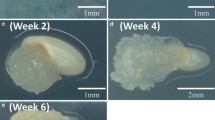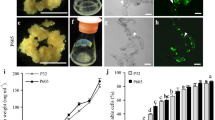Abstract
Key message
Selection of pre-embryogenic callus from a core structure from mature seed-derived callus is the key for high-efficiency plant regeneration and transformation of switchgrass different cultivars.
Abstract
Switchgrass (Panicum virgatum L.) has been identified as a dedicated biofuel crop. For its trait improvement through biotechnological approaches, we have developed a highly efficient plant regeneration and genetic transformation protocol for both lowland and upland cultivars. We identified and separated a pre-embryogenic “core” structure from the seed-derived callus, which often leads to development of highly regenerative type II calluses. From the type II callus, plant regeneration rate of lowland cultivars Alamo and Performer reaches 95 %, and upland cultivars Blackwell and Dacotah, 50 and 76 %, respectively. The type II callus was also amenable for Agrobacterium-mediated transformation. Transformation efficiency of 72.8 % was achieved for lowland cultivar Alamo, and 8.0 % for upland cultivar Dacotah. PCR, Southern blot and GUS staining assays were performed to verify the transgenic events. High regenerative callus lines could be established in 3 months, and transgenic plants could be obtained in 2 months after Agrobacterium infection. To our knowledge, this is the first report on successful plant regeneration and recovery of transgenic plants from upland switchgrass cultivars by Agrobacterium-mediated transformation. The method presented here could be helpful in breaking through the bottleneck of regeneration and transformation of lowland and upland switchgrass cultivars and probably other recalcitrant grass crops.




Similar content being viewed by others
Abbreviations
- 2,4-D:
-
2,4-Dichlorophenoxyacetic acid
- BAP:
-
6-Benzylaminopurine
- CH:
-
Casein hydrolysate
- GA:
-
Gibberellin
References
Aitchison PA, Macleod AJ, Yeoman MM (1977) Growth patterns in tissue (callus) cultures. In: Street HE (ed) Plant tissue and cell culture. Univ. of California Press, Berkeley and Los Angeles, pp 267–387
Armstrong CL, Green CE (1985) Establishment and maintenance of friable, embryogenic maize callus and the involvement of l-proline. Planta 164:207–214
Bhojwani SS, Dantu PK (2013) Tissue and Cell Culture. In: Bhojwani SS, Dantu PK (eds) Plant tissue culture: an introductory text. Springer, India, pp 39–50
Bouton JH (2007) Molecular breeding of switchgrass for use as a biofuel crop. Curr Opin Genet Dev 17:553–558
Burris JN, Mann DGJ, Joyce BL, Stewart CN Jr (2009) An improved tissue culture system for embryogenic callus production and plant regeneration in switchgrass (Panicum virgatum L.). Bioenergy Res 2:267–274
Carvalho CHS, Bohorova N, Bordallo PN, Abreu LL, Valicentle FH, Bressan W, Paiva E (1997) Type II callus production and plant regeneration in tropical maize genotypes. Plant Cell Rep 17:73–76
Fu CX, Xiao XR, Xi YJ, Ge YX, Chen F, Bouton J, Dixon RA, Wang ZY (2011) Down regulation of cinnamyl alcohol dehydrogenase (CAD) leads to improved saccharification efficiency in switchgrass. Bioenergy Res 4:153–164. doi:10.1007/s12155-010-9109-z
Gao YF, Zhu Z, Xiao GF, Zhu Y, Wu Q, Li XH (1989) Isolation of soybean kunitz trypsin inhibitor gene and its application in plant insect-resistant genetic engineering. Acta Bot Sin 40:405–411
Gressel J (2008) Transgenics are imperative for biofuel crops. Plant Sci 174:246–263
Guiderdoni E, Demarly Y (1988) Histology of somatic embryogenesis in cultured leaf segments of sugarcane plantlets. Plant Cell Tiss Org Cult 14:71–88
Hood EE, Gelvin SB, Melchers LS, Hoekema A (1993) New Agrobacterium helper plasmids for gene transfer to plants. Transgenic Res 2:208–218
Jefferson R (1987) Assaying chimeric genes in plants: the GUS gene fusion system. Plant Mol Bio Rep 5:387–405
Li RY, Qu RD (2011) High throughput Agrobacterium-mediated switchgrass transformation. Biomass Bioenergy 35:1046–1054
Lu C, Vasil IK (1981) Somatic embryogenesis and plant regeneration from leaf tissues of Panicum maximum Jacq. Theor Appl Genet 59:275–280
McLaughlin S, Bouton J, Bransby D, Conger B, Ocumpaugh W, Parrish D, Taliaferro C, Vogel K, Wullschleger S (1999) Developing switchgrass as a bioenergy crop. Perspectives on new crops and new uses. In: Janick J (ed) Perspectives on new crops and new uses. ASHS Press, Alexandria, pp 282–299
McLaughlin SB, Kiniry JR, Taliaferro CM, De La Torre Ugarte D, Donald LS (2006) Projecting yield and utilization potential of switchgrass as an energy crop. Adv Agron 90:267–297
Nageswara-Rao M, Soneji JR, Kwit C, Stewart CN Jr (2013) Advances in biotechnology and genomics of Switchgrass. Biotechnol Biofuels 6:77
Parmar SS, Sainger M, Chaudhary D, Jaiwal PK (2012) Plant regeneration from mature embryo of commercial Indian bread wheat (Triticum aestivum L.) cultivars. Physiol and Mol Biol Plants 18:177–183
Ramamoorthy R, Kumar PP (2012) A simplified protocol for genetic transformation of switchgrass (Panicum virgatum L.). Plant Cell Rep 31:1923–1931
Richards HA, Rudas VA, Sun H, McDaniel JK, Tomaszewski Z, Conger BV (2001) Construction of a GFP-BAR plasmid and its use for switchgrass transformation. Plant Cell Rep 20:48–54
Rueb S, Leneman M, Schilperoort RA, Hensgens LAM (1994) Efficient plant regeneration through somatic embryogenesis from callus induced on mature rice embryos (Oryza sativa L.). Plant Cell Tiss Org Cult 36:259–264
Sambrook J, Russell DW (2001) Molecular cloning. A laboratory manual, 3rd edn. Cold Spring Harbor Laboratory Press, Cold Spring Harbor
Somleva MN, Tomaszewski Z, Conger BV (2002) Agrobacterium-mediated genetic transformation of switchgrass. Crop Sci 42:2080–2087
Somleva MN, Snell DK, Beaulieu JJ, Peoples OP, Garrison BR, Patterson NA (2008) Production of polyhydroxybutyrate in switchgrass, a value-added co-product in an important lignocellulosic biomass crop. Plant Biotechnol J 6:663e78
Song GQ, Aaron W, Hancock JF (2012) Factors influencing Agrobacterium-mediated transformation of switchgrass cultivars. Plant Cell Tiss Org Cult 108:445–453
Vasil V, Vasil IK (1986) Plant regeneration from friable embryogenic callus and cell suspension cultures of Zea mays L. Plant Physiol 124:399–408
Vasil IK, Vasil V (1994) In vitro cultures of cereals and grasses. Kluwer Academic Publishers, Dordrecht, pp 293–312
Vogel KP (2004) Switchgrass. In: Moser LE, Burson BL, Sollenberger LE (eds) Warm-season (C4) grasses. American Society of Agronomy, Washington, pp 561–588
Vogel KP, Mitchell RB (2008) Heterosis in switchgrass: biomass yield in swards. Crop Sci 48:2159–2164
Welter ME, Clayton DS, Miller MA, Petolino JE (1995) Morphotypes of friable embryogenic maize callus. Plant Cell Rep 14:725–729
Xi YJ, Fu CX, Ge YX, Nandakumar R, Hisano H, Bouton J, Wang ZY (2009) Agrobacterium-mediated transformation of switchgrass and inheritance of transgenes. Bioenerg Res 2:275–283
Xu B, Huang LK, Shen ZX, Welbaum GE, Zhang XZ, Zhao BY (2011) Selection and characterization of a new switchgrass (Panicum virgatum L.) line with high somatic embryogenic capacity for genetic transformation. Sci Hortic 129:854–861
Zhang S, Hanna W, Ozias-Akins P (2007) Comparison of callus induction and plant regeneration from different explants in triploid and tetraploid turf-type bermudagrasses. Plant Cell Tiss Org Cult 90:71–78
Zhang WJ, Dewey RE, Boss W, Phillippy BQ, Qu RD (2013) Enhanced Agrobacterium-mediated transformation efficiencies in monocot cells is associated with attenuated defense responses. Plant Mol Biol 81:273–286
Acknowledgements
The work was supported by the National High Technology Research and Development Program (“863” 2012AA101801) of China, and Chinese Universities Scientific Funds (2012QJ120) to W.J.Z. We are grateful to Dr. Rongda Qu of NCSU for his critical reading and advices on the paper.
Conflict of interest
The authors declare that they have no conflict of interest.
Author information
Authors and Affiliations
Corresponding author
Additional information
Communicated by K. Wang.
Rights and permissions
About this article
Cite this article
Liu, YR., Cen, HF., Yan, JP. et al. Inside out: high-efficiency plant regeneration and Agrobacterium-mediated transformation of upland and lowland switchgrass cultivars. Plant Cell Rep 34, 1099–1108 (2015). https://doi.org/10.1007/s00299-015-1769-x
Received:
Revised:
Accepted:
Published:
Issue Date:
DOI: https://doi.org/10.1007/s00299-015-1769-x




